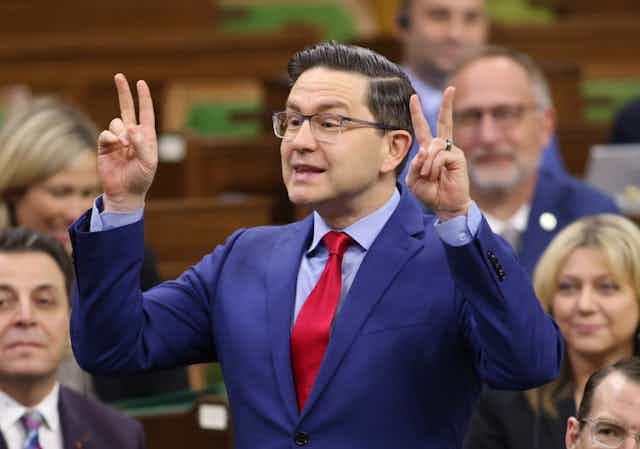Pierre Poilievre, leader of the Conservative Party of Canada, is attempting to mislead Canadians into believing that the Canadian Broadcasting Corporation is an untrustworthy news source after it was labelled “government-funded media” by Elon Musk’s Twitter.
In response, CBC paused its activity on Twitter, objecting to any suggestion the government has any control over its journalism.
Poilievre is suggesting Twitter’s designation is proof the CBC lacks editorial independence and is a Liberal government propaganda tool.
But that’s not what Twitter’s label is actually suggesting. For Poilievre to try to persuade Canadians that the label confirms CBC is an extension of the Liberal government is disingenuous and improperly discredits the legitimacy of government-funded enterprises.
Public plea
In early April, Poilievre made a public request to Musk to label the CBC “government-funded media,” saying Canadians should be protected against disinformation and manipulation by state media. From the outset, Poilievre was conflating news organizations that receive government funding as public broadcasters to state media outlets, which are controlled editorially by ruling governments.
After the request was granted, he again took to Twitter to signal that the public broadcaster has officially been exposed as “government-funded media,” thereby suggesting that it can no longer be considered trustworthy.
What Poilievre apparently forgot to mention is that there are important differences in Twitter’s seemingly arbitrary verification labels. Failing to explain these differences suggests he’s just trying to score political points or, worse, is intentionally misleading Canadians.
According to Twitter’s media account label policies, there’s a distinction between the “government-funded” and “state-affiliated” labels.
The “government-funded” title is used to indicate that some or all of the media outlet’s funding is provided by government.
The “state-affiliated” label, on the other hand, is used to describe media outlets that are directly controlled by the state in terms of editorial content via a variety of ways, including financial resources, direct or indirect political pressure or control over the production and distribution of media content.
Not a warning
The “government-funded” label doesn’t appear to suggest any sort of warning or raise cause for concern about the outlet’s objectivity and independence. Instead, it reads simply as describing a media entity that receives funding from the government.
The “state-affiliated” label, however, is an indication of political interference in a media outlet’s journalism.
Poilievre appears to deliberately conflate the two labels, which suggests he wants Canadians to believe that the Liberal government is exerting direct political control over the CBC because it receives funding from the government.
Not only is this misleading but it appears to exploit three connected challenges:
Most Canadians are unaware of how government agencies and systems work;
The majority of Canadians get their news from social media;
Younger Canadians are more trusting of information received from social media platforms like Facebook, Instagram and Twitter.
Grasping the nuances
Not everyone understands the nuances of how Canadian government works and fewer recognize the complexity of the institutions that make up the administrative state, which the CBC is part of as a Crown corporation.
In order for the public to be protected against disinformation, the complexities of the Canadian government shouldn’t be dismissed out of hand the way they apparently were by a spokesperson for CBC. That spokesperson insisted that all Canadians know the CBC/Radio-Canada is publicly funded and its editorial independence is protected by law via the federal Broadcasting Act.
Like many other Crown corporations — including Canada Post, Via Rail and the Bank of Canada — the CBC is a state-owned enterprise designed to carry out functions at an arm’s length from the government. Crown corporations operate similarly to large for-profit companies, but they’re public organizations that fulfil both commercial and public policy objectives.
In light of this, there’s nothing unsurprising or scandalous about designating the CBC as “government-funded” since it’s a Crown corporation, not the arm of a political party. The CBC has cast a critical eye on governments of all stripes and at all levels since its inception, whether those governments were Conservative, Liberal or NDP.

Taxpayer funds
Nearly two-thirds of the CBC’s funding come from taxpayers and is therefore subjected to parliamentary oversight. The public broadcaster maintains editorial independence, regardless of what party’s in power, and receives its funding through a vote in Parliament.
Overlooking this fact makes it easier to believe that the CBC perpetuates “Trudeau propaganda,” which is no more true than if the CBC is accused of peddling “Poilievre propaganda” if he wins the next federal election.
This doesn’t mean the CBC, like any news organization, is without flaws — and perhaps there’s cause to re-evaluate the role Canada’s national broadcaster plays in the country’s rapidly evolving society.
But misleading Canadians by conflating Twitter’s media account verification labels, as Poilievre has done, is not the way forward.
While Poilievre is correct that Canadians should be shielded from disinformation and manipulation, they should also be cautious of politicians misleading them on complex issues regarding the independence and impartiality of government agencies.

